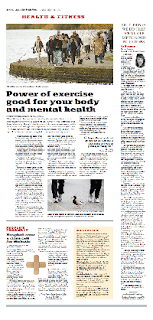OK, so here’s my big news: As of today, I am officially a nutrition columnist for The Seattle Times (there’ll be some fitness in the mix, too). It’s a freelance gig, and how often my column will appear hasn’t been totally nailed down yet. Looks like at least every three weeks.
My first column is in the print edition of the paper (so go out and buy it, if you live in the greater Seattle area!). Alternatively, I’m running it here, along with a tiny little photo of the page it runs on (it’s that loooong column down the right side). I hope everyone’s having a great weekend!
On Nutrition
Carrie Dennett
Special to The Seattle Times
If the road to success is paved with good intentions, I’ll wager that a good 75 percent of that pavement is poured from the intent to eat right and get in shape. While people don’t set out to purposefully sabotage their efforts, an awful lot of derailment goes on, nonetheless. Sometimes it’s because we’re just not thinking; sometimes it’s because we’re overthinking. I’ve made every one of the following mistakes at some point. What about you?
- Failing to plan. Rome wasn’t built in a day, and those sketchy eating habits you’d like to change weren’t either. Changing habits can be hard work, so thinking you can turn yourself into a healthier eater without a game plan is guaranteed to leave you spinning your wheels. If you don’t have a plan, you will slip into “default mode” (aka your old habits) time and time again. “I want to eat healthier” is vague. “I will bring fresh fruit to work for snacks instead of hitting the vending machine” is a plan.
- Not having a nutritional gatekeeper. Most of us tend to eat more of what is close at hand, so if unhealthful snacks, sugary beverages and pints of ice cream are constantly breaching your household gates, guess what’s probably going down the hatch. Purge your home of the junk and stock it with healthful foods that suit your tastes and your lifestyle, and you’ve immediately streamlined your path to better health. This is especially important if you find you often arrive home from work ravenous, or if you are prone to eating out of stress or boredom.
- Being a garbage disposal. Classic examples are nibbling left-behind food off your kids’plates when cleaning up and letting your grandmother serve you “that last little bit” even though you’re full. Repeat after me: “Better to go to waste than to go to my waist.” Do you ever eat crackers that are stale or day-old break-room doughnuts? Do you eat enough to get your “money’s worth” at buffet brunches? Being a member of the Clean Plate Club rarely does anyone any favors.
- Not seeing the forest for the trees. Do you fuss about eating the latest, greatest exotic “superfood”? Try focusing your efforts—and food dollars—on including ample amounts of familiar vegetables and fruits into your meals and snacks each day. If you find yourself putting off eating healthier while you fret about what ratio of carbs/protein/fat you “should” eat, shift gears and regain dietary sanity by getting down to the basics: Eat more vegetables, cut back on junk food and dial down portion sizes.
- Making every day “special.” There are a handful of days of the year that warrant a little dietary splurging. Your birthday. Your anniversary. Major holidays. A rare visit from dear, long-distance friends. You get the idea. You’ll notice I didn’t mention Fridays or crazy work days. Healthful eating leaves room to enjoy cake on your birthday and a helping of your family’s secret-recipe stuffing on Thanksgiving. But if you celebrate every co-worker’s birthday and each minor holiday with rich desserts and calorific meals, you’ll need to buy bigger pants.
There’s more to healthful eating than this, of course, but seeing these traps and learning to sidestep them can greatly improve the quality and quantity of what you put in your mouth. And that can lead to better health, and possibly smaller pants. Next time: moderation. It doesn’t mean what you think it means.
Carrie Dennett: nutritionbycarrie@gmail.com; Dennett is a graduate student in the Nutritional Science Program at UW; her blog is nutritionbycarrie.com.







